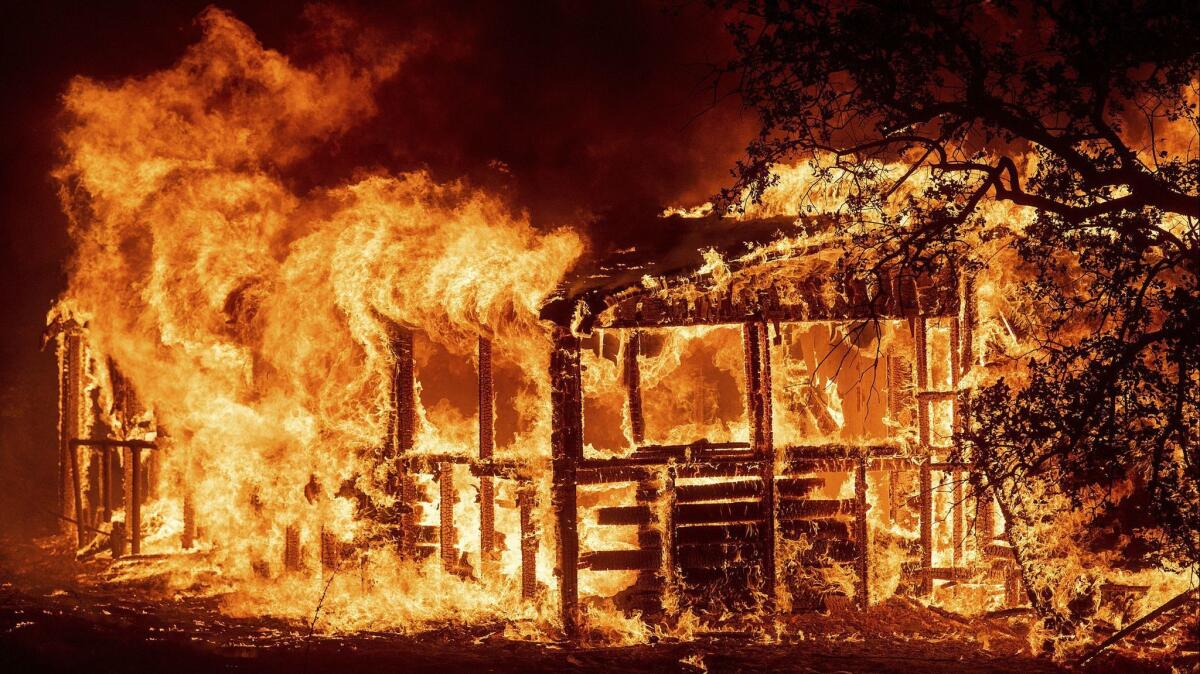A year of fire and rain and the new normal

People unattuned to the subtle shifts in California’s weather like to complain that we have no seasons here.
Of course we have seasons.
We have drought, followed by fires, followed by rain, followed by mudslides.
We can’t predict when drought will beset us, exactly, but we can predict the cascade of problems that will follow a dry spell, especially when the Santa Anas or the Diablos or the sundowners begin to blow over tinder-dry landscape, wicking away every last ounce of moisture.
This year, meteorologists said, the winds were stronger than usual and lasted longer than usual. Up and down the state, they pushed over trees, which fell onto power lines, which sent up explosions of sparks, which ignited brush and more trees. The winds sent embers shooting like flaming arrows along the landscape. Borne on a wildly flowing, invisible river of wind, the embers touched down, torching homes and cars, sometimes even creating their own weather systems.
Over the summer, near Redding, climatological conditions combined to create one of the most terrifying natural disasters imaginable: a fire cyclone. On July 23, a couple towing a vacation trailer had a flat tire. When the metal rim hit the pavement, sparks flew into parched grass, touching off a wind-whipped blaze in the 113-degree heat. By evening, cool coastal air blew into the Sacramento Valley. The air masses collided, creating a 30,000-foot-high spinning convection column that became a cyclone of flames.
If an alarm goes up early enough, residents threatened by wildfire are able to evacuate. Some stubbornly stay and regret it. But others are caught off guard, or move too slowly, and find themselves trapped in flames, or running or driving through hell to find safety.
In 2018, we lost a sobering number of souls this way.
In Redding, eight people died in the Carr fire, including a 70-year-old woman and her two young great-grandchildren, trapped at home without a car.
Three and a half months later, in Paradise, a retiree-filled mountain town near Chico, at least 86 people died in the Camp fire, which began Nov. 8 and is now considered the deadliest, most destructive fire in recorded state history.
Three people are still missing. Almost 14,000 homes were lost, along with thousands of other buildings.
The town, which the local paper had warned was a fire disaster waiting to happen, will take years to recover.
The 2018 wildfire season is the worst on record in California. (And 2017 was the worst wildfire season before that.) More than 8,000 fires burned some 1.8 million acres, causing preliminary damage tallying at least $11 billion. More than 100 people died, including at least six firefighters.
Given global climate change, experts say, these kinds of fires may well be California’s new normal.
::
Just as fire season ends, if we are lucky, the rains begin.
Blessedly, the air clears and the lingering, acrid smell of smoke recedes. But a new danger threatens foothill and mountain communities near burn areas: flooding and mudslides, which, like fire, can come without warning.
Indeed, California’s first natural cataclysm of 2018, the Montecito debris flow, was the result of the last cataclysmic event of 2017, the Thomas fire, a massive conflagration that scorched land from Ventura County to Santa Barbara County and briefly held the mantle of the state’s largest wildfire.
In the wee hours of Jan. 9, half an inch of rain fell in five minutes, and the mountains above the tony, bucolic town that is home to celebrities such as Oprah Winfrey and Jeff Bridges seemed to give way.
Mud, rocks and boulders came raging down from the Santa Ynez Mountains, burying, crushing or sweeping away everything in their path.
In trying to describe a mudflow, a Santa Barbara geologist suggested picturing a 15-foot-high river of mud moving at 20 mph, so viscous that one- and two-ton boulders could bounce along the surface, like pingpong balls, obliterating everything in their path.
The debris flow came down the gulleys and creeks, crossed the 101 Freeway, then flowed into the sea, where for weeks, the waves stayed the color of mud.
Twenty-one people died in that mudflow, and two children remain missing, their bodies perhaps washed out to sea. More than 125 homes were completely destroyed; 300 more were damaged.
More and more in California, it feels as if no place is immune from the ravages of our seasons.
Last year’s wine country fires, which killed 44 people, taught us that fire combined with hurricane-force winds can level populated suburban neighborhoods that have never before been considered susceptible to wildfire.
Two Santa Rosa hospitals right next to the 101 were singed and evacuated. A nearby Kmart in the middle of a shopping center, surrounded by blacktop, burned to the ground.
But even populations hundreds of miles away from a fire can suffer.
While the Camp fire raged in the piney mountains around Paradise, the air quality as far away as San Francisco — 170 miles southwest — became so bad that parents feared for their children’s health. Bay Area school districts and University of California campuses cancelled classes.
Likewise, in November, when the Woolsey fire burned from Thousand Oaks through Malibu to the beach, Santa Monicans choked on smoke.
It is winter now. The fires are out.
The rains have come.
Our next disaster may be only a storm away.
Unless we have an earthquake first.
Twitter: @AbcarianLAT
More to Read
Start your day right
Sign up for Essential California for news, features and recommendations from the L.A. Times and beyond in your inbox six days a week.
You may occasionally receive promotional content from the Los Angeles Times.







